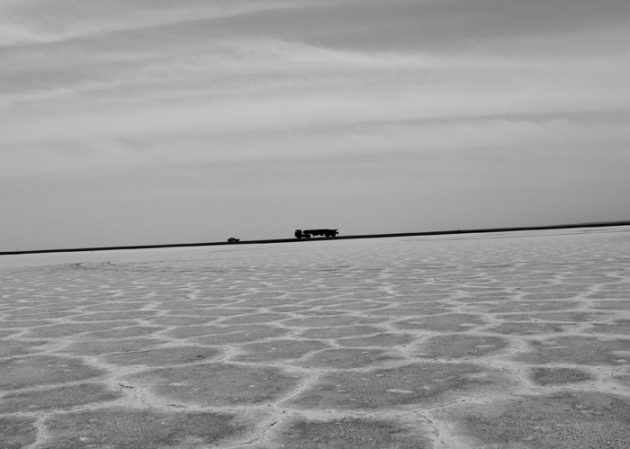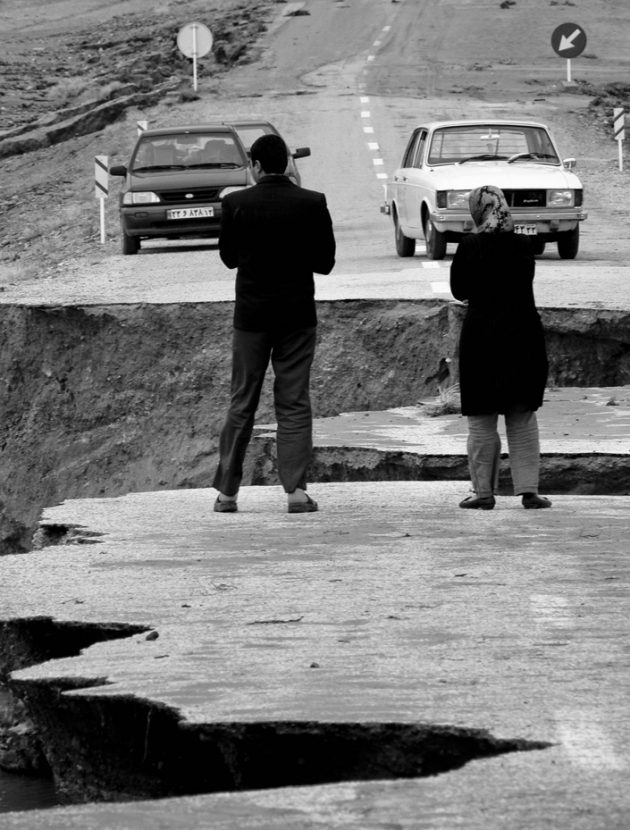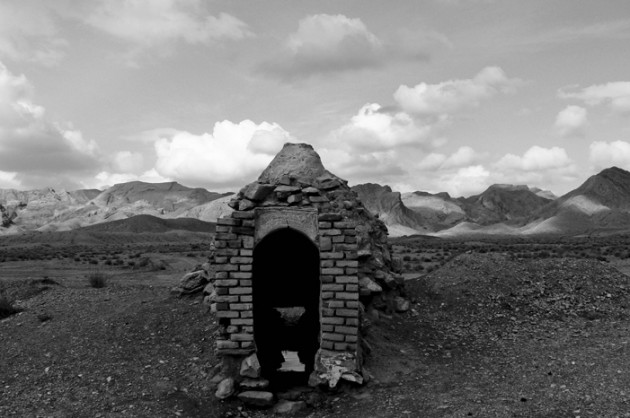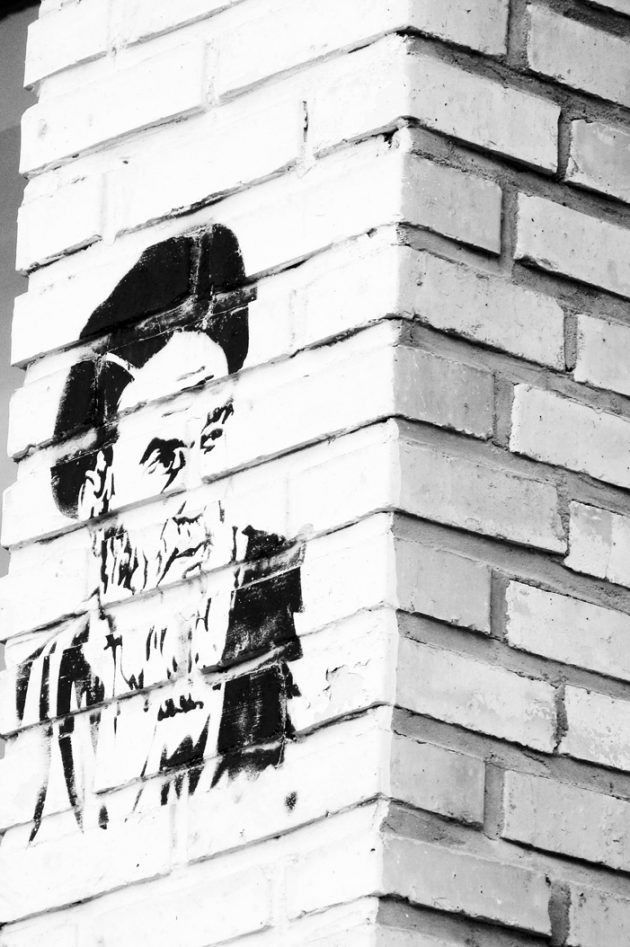

With time before the two o’clock bus left Esfahan, I set off into the bus station. A delicate young man watches me, his hair beginning to thin, his face North Sea European with Semitic eyes of onyx; a short man, serious, dressed in tight stone-wash jeans, a belt with an elaborate Zoroastrian buckle, a slick shirt, a silver chain. He approaches. I recognise him from a bus ride earlier, watching me then. He recognises my lack of direction and leads me to a fast food stand.
My name is Ali Reza Yas. I am a rapper. I live in Berlin.
I order two falafel sandwiches, he translates and I ask:
Sprechen Sie Deutsch?
No, no, no. Yas. Yas. My name is Yas. Yas. Say it: Yas.
Yas?
Yas.
Yas.
Good. Yas.
We stand in silence, watching the falafel bounce and fizz in the oil of ruby and copper, side-ways smiling until I’m handed my order and he leaves. Returning to the bus, it dawns on me. Yas is a famous Farsi rapper, a Tehrani in his late twenties. I had read about him in the National Geographic. Could this have been the Yas?
A week later I see him again in Esfahan standing in the doorway of his father’s men’s clothing shop and follow him inside. He plays his most famous track Hoviat-e Man – My Identity – a video on his mobile phone, a song redolent with Persian pride accompanying images of Persepolis. Zoroastrian first, Muslim second like many Iranians, he shows admiration for the late Shah, a head-shaking hatred of the late Ayatollah Khomeini. He asks how I can help him against the regime, pleads for me to put him in contact with the British Embassy, speaks of the need for guns. He withdraws a photo from a leather pouch. With the Zayandeh River in the background, he stands with a woman, a former wife. Their expressions are neutral, a mood difficult to gauge. This was a contract marriage, a six month deal, as is sometimes the custom in this country where living in sin can be a capital crime. They are no longer together. He shows me a pornographic clip involving naked beauties and an everyday bodily function and asks thirstily: You have in your country? I leave before I become an unwitting accessory to treason, or worse. This eccentric cameo is almost too contrived to be real. He is definitely not the Yas, but I wonder who he really is, why he is playing a game of make believe with a foreigner.
The Mercedes Benz bus, painted flaking red and cream with aluminium trim and zigzags of Farsi, is a veteran vehicle, well-taken care of, panting along the asphalt road into the Dasht-e Kavir, along a caravan route, tributary of the Silk Road that heads all through this Great Salt Desert to Mashhad, onwards further to Xian. I stare at the barren oatmeal, forbidding life, eroded by the elements, its own self-loathing nature. One sixth of the Iran is desert. The driver’s young assistant lunges a pack at each of us: dry wafer biscuit, hard boiled sweet, a foil bag of juice to harpoon with a straw, a plastic cup for water. The standard ration of bus trips in Iran. It is a cramped, jolting ride and we supplement this with yoghurt pot sized tubs of paneer, stale nan crumbling like ancient papyrus over our knees. Night settles quickly greying and submerging the fulvous dust, the sultana hills become monstrous shadows. I sleep and wake to see a lightening storm raging over the east, over jagged hills an electric sky.
Getting off in the town of Khoor is confusion of “what next?” as a small crowd of the curious surround us trying to be helpful. A woman in a small shop knows sparse English and there is rumour of a hotel in town. A man takes us in his car a short distance away along alleyways of adobe walls, into a courtyard. He waits while we agree a price for a room: money is not the issue, language is. The storm catches us, the first wave of atmospheric assault, a flash of threatening palm trees, triffid-like, ghostly houses, blacked out windows, and white tridents then blankness and the sound of thunder, wind, rain.
Early start, an indigo morning, our headlights smear the adobe walls before they are swallowed in shadow until we reach the main road and pick up speed passing the pink shop-fronts, the mayor’s favourite colour, the paint his gift, his directive. We drive ten, twenty, thirty kilometres at speed, the ink sky diluted by grey clouds denying sunrise. We stop by the road side. The momentous rain of last night is evident. The salt encrusted desert, ordinarily a mosaic of saline veins, is transformed into solid bog, brown waves stopped in their tracks. Huge puddles, rivers that do not flow, only seep. The mountains are cocoa beneath a lavender sky, which begins to brighten. At intervals the air blast blare of oil lorries bang by, horns wailing; chunky cream-coloured Paykan cars with over-loaded roofs rush. We go back the way we came.
Months before, Khoor’s four hundred year old oasis pride was an orchard of date palms. Children fooling with fire brought disaster and everything was lost in a single night. The clean up is taking place, a yellow bulldozer, two steam rollers, clearing the final debris, charcoal twists of logs on russet mud as puddles glint. An unfinished mosque lords over the town, the cupola a ribbed frame like balsa wood. There is a wind tower. Khoor is a clutter of adobe walls and block houses, a jumble of palm trees in hidden gardens. We walk through what seems to be an abandoned edge of town along narrow irrigation channels, the vital arteries. We find a small bath house, green water like dank dockland sea, graffiti on the walls.

We have to stop. Given last night’s storm, it is no surprise, but the road to Garmeh is ripped in two, lost in the dirt and stones. Washed away, a flash flood in the night but the water is gone. Like other onlookers we stand not quite comprehending, but drive on, seek another way. Garmeh is old, wise, nurturing human life for several thousand years, staying in reach but out of touch. It is mentioned in Safarnama, the poet Nair Khusraw’s Book of Travels. He stopped in this haven almost a millennium ago during his wandering seven year pilgrimage to Medina and Mecca covering 19,000 kilometres.
We drink tea in a house of four centuries standing with secret passages leading off the central courtyard of stone, next to a ruined mud mound citadel of the Sassanian period, possibly fifteen hundred years old. Camels in a pen limber over, hopeful of food, slightly disgruntled that we have none. There are date palms and pomegranate trees in the garden. Nearby there is a place of worship built of sand. We explore the oasis. Like Khoor there are scorched trees, ashen stumps with palm leaf stalks black and flocculent like spiders’ legs. We learn that winter snow rotted the trees, caused disease that could only be purged by flames. We walk to the town’s water source, a stream pouring from a hidden spring in hill of paprika, streaking through powdery soil. Tiny translucent fish spark beneath the shallow surface.
 At my friend’s home we are greeted and seated on the sofa, handed scalding glasses of tea, proffered ghand. Guests are a gift from God and we are accorded this honour. The women sit along the far wall of the living room or work in the kitchen. There are sisters and cousins, mothers and aunts of every generation. It is hard not to stare, as they adhere to the dress code of Islam, the hijab reminiscent of a nun’s wimple. The face is our focus, the only reference, a superficial measure of personality when spoken language is lost. An uncle, a teacher who speaks some English, talks to us, small talk. On the living room wall are pictures of Mahmoud Ahmadinejad, the wily, grinning President of the Islamic Republic, and Ayatollah Seyyed Ali Khamenei, the spiritual and supreme leader of Iran, whose soft bespectacled eyes and white beard bely a steely devotion to the ideals of 1979, a ruthless that matches his predecessor.
At my friend’s home we are greeted and seated on the sofa, handed scalding glasses of tea, proffered ghand. Guests are a gift from God and we are accorded this honour. The women sit along the far wall of the living room or work in the kitchen. There are sisters and cousins, mothers and aunts of every generation. It is hard not to stare, as they adhere to the dress code of Islam, the hijab reminiscent of a nun’s wimple. The face is our focus, the only reference, a superficial measure of personality when spoken language is lost. An uncle, a teacher who speaks some English, talks to us, small talk. On the living room wall are pictures of Mahmoud Ahmadinejad, the wily, grinning President of the Islamic Republic, and Ayatollah Seyyed Ali Khamenei, the spiritual and supreme leader of Iran, whose soft bespectacled eyes and white beard bely a steely devotion to the ideals of 1979, a ruthless that matches his predecessor.
My friend asks: What do you think of Ahmadinejad?
I ponder and take the diplomatic approach, a partial truth: I don’t know much about him.
Three months later I know more about him and the regime, or think I do. Amid allegations of election rigging in the presidential poll, there are mass protests on Tehran’s streets, martyrs born, and ultimately a Twitter revolution is crushed. We never do see the reaction of these small town people on our television screens. I wonder if the quiet majority do actually support Ahmadinejad and the status quo. I realise we only want to see a version of events that supports our own world view. People like us fighting for freedom, a life like we have. I still don’t know much about him.
We eat, sitting on the floor as is customary, barbecued chicken pieces, legs and wings saffron-coloured, with white rice, salad of chervil, coriander, wild mint and rocket, yoghurt and nan. My friend’s grandfather and uncles speak in the local language of the desert, an ancient Zoroastrian tongue. Afterwards, outside on a concrete forecourt, Farsi techno music cries from the speakers of a car radio. Clapping women of the family form a semi-circle. The men dance, perform subconsciously, limbs fed by the quivering sounds, a rhythm of upper bodies, arms and high up hands, hips and leg motion understated. They are swift yet somehow linger, luxuriate. Pulled into the scene to join, we resist politely, but succumbing is easier, refusal is no option, too ungracious. We are clumsy, causing merriment that is only gently mocking and we laugh at ourselves. The other men encourage, dance up close to us. We try to mirror, but only parody. The women continue to laugh, continue to clap. It reminds me of Purim parties in the Holy Land.
Next day, Sizdah be-dar is the thirteenth and final day of Norouz. In the desert by a breeze block house close to a marble quarry, we see the women dance together. The men have to go away. They cannot watch, but we are permitted to stay.

Steven Tizzard is a historian, writer and traveller. His most recent journey was overland from Osaka to London and followed some of the main routes of the Silk Road.